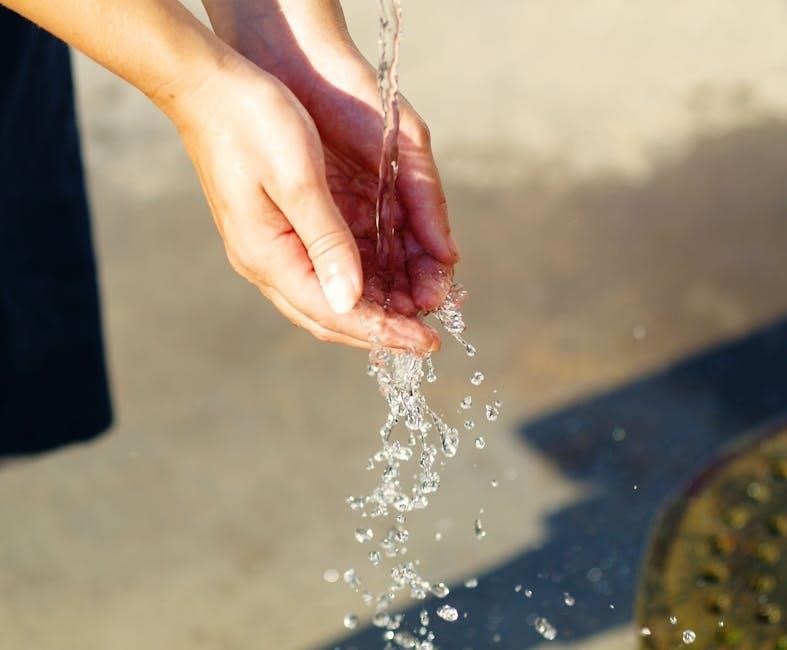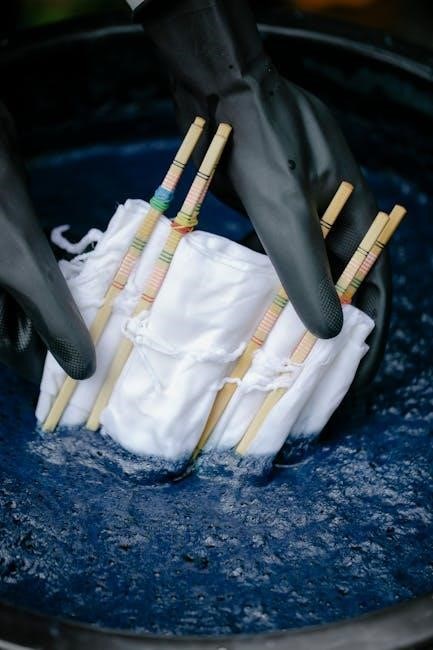Orbit Water Timer Instruction Manual: A Comprehensive Guide
This guide provides comprehensive instructions for your Orbit water timer․ From mechanical to digital models, learn how to set up, program, and troubleshoot your timer․ Achieve optimal watering efficiency, integrate drip irrigation, and identify your specific model․ Customer support and resources are also available․
Understanding Orbit Water Timer Basics
Orbit water timers offer a convenient way to automate your lawn and garden watering․ They eliminate the need to manually turn your sprinklers on and off, saving you time and water․ These timers connect directly to your outdoor faucet and control the flow of water to your sprinkler or drip irrigation system, ensuring consistent watering even when you’re away․
The fundamental principle behind all Orbit water timers is timed watering․ You set the desired duration and frequency of watering, and the timer automatically follows your schedule․ This precise control helps prevent overwatering and conserves water resources․
Orbit offers a range of water timers, from simple mechanical models to advanced digital versions․ Mechanical timers are easy to use, requiring no batteries, while digital timers offer more advanced programming options․ Understanding these basics is crucial for selecting the right timer and effectively using it to maintain a healthy landscape․ Regardless of the type, all Orbit timers prioritize user-friendliness and efficient water management․
Familiarizing yourself with the basic components and functions will make programming and troubleshooting much easier․ By understanding the core principles, you’ll be able to tailor your watering schedule to the specific needs of your plants and maximize water conservation․
Types of Orbit Water Timers: Mechanical vs․ Digital
Orbit offers two primary types of water timers: mechanical and digital․ Mechanical timers are the simpler of the two, operating without the need for batteries or electricity․ They feature a dial that you twist to set the desired watering duration, typically ranging from 15 to 120 minutes․ Once set, the timer mechanically counts down and shuts off the water flow when the time is up․ These timers are known for their ease of use and reliability, making them a great choice for basic watering needs․
Digital timers, on the other hand, offer more advanced features and greater flexibility; They use electronic components and require batteries to operate․ Digital timers allow you to set specific start times, watering durations, and frequencies, giving you precise control over your watering schedule․ Many digital models also include features like rain delay, which pauses watering when it rains, and manual override, which allows you to water outside of the set schedule․ With their advanced programming capabilities, digital timers are ideal for users who want customized and efficient watering․

Choosing between mechanical and digital timers depends on your individual needs and preferences․
Mechanical Orbit Water Timer: Operation and Setup
The Orbit mechanical water timer is designed for simple and straightforward operation․ Setting up your mechanical timer involves a few easy steps․ First, ensure the timer is securely attached to your outdoor faucet or hose bib․ Most mechanical timers have a standard threaded connection that easily screws onto the faucet․ Make sure the connection is tight to prevent leaks․ Next, connect your garden hose or sprinkler system to the outlet side of the timer․
Operating the timer is even simpler․ The large dial on the timer is used to set the watering duration․ Typically, you’ll find markings indicating the time in minutes, usually ranging from 15 minutes to 120 minutes․ To set the timer, simply twist the dial to the desired watering time․ The timer will immediately begin counting down, and water will flow through the system․
Once the set time has elapsed, the timer will automatically shut off the water flow․ Many mechanical timers also feature a manual override option․ This allows you to bypass the timer and manually control the water flow․ This is useful for tasks like washing your car or filling a bucket without having to remove the timer․ The mechanical operation of these timers requires no batteries, making them a reliable and convenient solution for basic watering needs․
Digital Orbit Water Timer: Programming Instructions
Programming your digital Orbit water timer involves several key steps to customize your watering schedule․ First, familiarize yourself with the timer’s interface, which typically includes buttons for setting the clock, start times, watering duration, and frequency․ Begin by setting the current time and day․ This is crucial for the timer to operate according to your programmed schedule․ Use the designated buttons to adjust the hour, minute, and day of the week․
Next, define your watering schedule by setting the start time, duration, and frequency․ The start time determines when the watering cycle will begin․ You can usually set multiple start times per day, depending on your specific model․ The duration specifies how long the watering will last, ranging from a few minutes to several hours․ The frequency determines how often the watering cycle will repeat, such as every day, every other day, or on specific days of the week;
Most digital timers offer advanced features like rain delay, which pauses the watering schedule when rain is detected․ Some models also have manual watering options, allowing you to override the programmed schedule for immediate watering needs․ Always refer to your specific model’s manual for detailed instructions and troubleshooting tips․ Correct programming ensures efficient and reliable watering, saving water and promoting healthy plant growth․
Setting the Clock on Digital Timers
Setting the clock on your digital Orbit water timer is a foundational step for accurate and timely watering․ The timer relies on the correct time of day to execute your programmed watering schedules effectively․ Begin by locating the “Set Clock” or similarly labeled button on the timer’s control panel․ Pressing this button usually activates the clock setting mode, indicated by flashing digits on the display screen․
Once in clock setting mode, use the “+” and “-” buttons to adjust the hour and minute․ Some models may have separate buttons for each․ Ensure you select the correct AM or PM setting, if applicable․ After setting the time, you’ll typically need to set the current day of the week․ Again, use the “+” and “-” buttons to scroll through the days until the correct one is displayed․
After setting both the time and day, press the “Enter” or “OK” button to save your settings․ The display should then revert to the normal operating mode, showing the current time․ It’s crucial to double-check that the time and day are accurate to avoid any disruptions to your watering schedule․ Incorrect clock settings can lead to watering at unintended times, potentially wasting water or harming your plants․ Regularly verify the clock, especially after power outages, to maintain optimal timer performance and prevent scheduling errors․
Programming Watering Schedules: Frequency and Duration
Programming watering schedules involves setting both the frequency and duration of your watering cycles․ This is where you define how often and for how long your sprinklers or drip system will run․ Begin by selecting the “Program” or “Schedule” option on your Orbit timer․ This typically allows you to create multiple independent watering programs, labeled A, B, and C․
Within a program, you’ll first set the watering frequency․ Options often include watering on specific days of the week (e․g․, Monday, Wednesday, Friday), every other day, or at set intervals (e․g․, every 1 hour, 3 hours, 12 hours, or from 1 to 7 days)․ Select the option that best suits your plants’ needs and local watering restrictions․
Next, set the watering duration․ This determines how long each watering cycle will last․ Consider your plant types, soil conditions, and sprinkler output when deciding on a duration․ Shorter durations are suitable for drip irrigation or plants requiring less water, while longer durations are appropriate for lawns and plants needing thorough soaking․ Input the desired watering time in minutes using the “+” and “-” buttons․ Finally, save your settings to activate the watering schedule․ Remember to review your settings periodically and adjust them as needed to accommodate seasonal changes or plant growth․
Manual Override Function: How to Use It
The manual override function on your Orbit water timer provides a convenient way to water outside of your programmed schedule․ This is useful for tasks such as spot-watering new plants, testing sprinkler heads, or providing extra water during a heatwave․ To activate the manual override, locate the “Manual” or “Run” button on your timer․
Pressing this button typically initiates an immediate watering cycle․ Some timers may offer a simple on/off manual mode, while others allow you to select a specific zone or station to water manually․ If your timer has zone selection, use the “+” and “-” buttons to choose the desired zone․
Once the zone is selected, you can often set the duration of the manual watering cycle․ This allows you to control how long the water will run․ Input the desired time using the “+” and “-” buttons․ If your timer doesn’t offer duration control, it may run the manual cycle for a preset amount of time or until you manually turn it off․ To stop the manual watering cycle, either press the “Manual” or “Run” button again, or wait for the set duration to expire․ Remember to return your timer to its automatic mode after using the manual override function to ensure your programmed schedule resumes․

Troubleshooting Common Issues
Even with careful setup, you may encounter issues with your Orbit water timer․ One common problem is the timer not watering at the scheduled times․ Ensure the clock is set correctly and that the program is active․ Check that the start times and watering durations are properly configured and that the timer is not in “Rain Delay” mode․ Also, verify the battery level, as a low battery can disrupt the timer’s operation․

Another frequent issue is a zone not watering․ Inspect the wiring connections to that zone’s valve․ Loose or corroded wires can prevent the valve from opening․ Also, check the valve itself for any obstructions or damage․ If the valve is faulty, it may need to be replaced․ If water is leaking from the timer or valve, tighten all connections and check for cracks or damage to the components․
If the timer displays an error message, consult your Orbit water timer manual for specific troubleshooting steps related to that error code․ For digital timers, a power surge can sometimes cause the timer to malfunction․ Try resetting the timer by removing the battery and disconnecting the power adapter for a few minutes before reconnecting them․ If problems persist, contact Orbit customer support for further assistance․
Watering System Audit for Optimal Efficiency
To maximize the effectiveness of your Orbit water timer, conduct a thorough watering system audit․ This involves assessing your current watering practices and identifying areas for improvement․ Begin by examining your sprinkler heads․ Ensure they are properly aligned and free from obstructions․ Adjust or replace any broken or clogged heads to ensure even water distribution․ Check for leaks in your system, particularly around sprinkler heads and valve connections․
Next, evaluate your soil type and plant needs․ Different plants require varying amounts of water․ Group plants with similar watering requirements together to avoid over or under-watering․ Consider using drip irrigation for plants that benefit from targeted watering, such as gardens and shrubs․ Monitor the weather and adjust your watering schedule accordingly․ Avoid watering during periods of rain or high winds․
Calculate your watering run times based on plant needs and soil infiltration rates․ Use a rain gauge to measure how much water your system is applying․ Adjust your timer settings to deliver the appropriate amount of water to each zone․ Regularly inspect your system and make adjustments as needed to maintain optimal efficiency․ By conducting a water audit, you can conserve water, save money, and promote healthy plant growth․
Drip Irrigation System Integration
Integrating a drip irrigation system with your Orbit water timer is a smart way to conserve water and deliver targeted hydration to your plants․ Drip irrigation systems deliver water directly to the root zone, reducing water waste through evaporation and runoff․ Begin by designing your drip system based on your garden layout and plant needs․ Select the appropriate tubing, emitters, and connectors․
Connect the drip system to your Orbit water timer using a backflow preventer and a pressure regulator․ The backflow preventer prevents contaminated water from flowing back into your water supply, while the pressure regulator ensures that the drip system operates at the correct pressure․ Program your Orbit timer to deliver water at the desired frequency and duration for your drip system․ Consider factors such as plant type, soil type, and weather conditions when setting your watering schedule․
Regularly inspect your drip system for leaks or clogs․ Clean or replace emitters as needed to ensure even water distribution․ Adjust the timer settings as your plants grow and their water needs change․ With proper planning and maintenance, a drip irrigation system integrated with your Orbit timer can provide efficient and effective watering for your garden, saving you water and promoting healthy plant growth․ This method is becoming more user-friendly for individuals․
Orbit Timer Model Identification
Identifying your specific Orbit timer model is crucial for accessing the correct programming instructions and troubleshooting information․ Orbit offers a variety of timer models, each with its unique features and functionalities․ The model number is typically located on the timer itself, often on the front or back panel․ Look for a sticker or label that displays the model number, which may be a combination of numbers and letters․
Once you have located the model number, you can use it to find the corresponding instruction manual on the Orbit website․ The website provides a comprehensive library of manuals for all Orbit timer models․ If you are unable to find the model number on the timer, you can also try searching for it online using keywords such as “Orbit water timer” and any other identifying features, such as the number of zones or the type of display․
Alternatively, you can contact Orbit customer support for assistance in identifying your timer model․ Provide them with any information you have about the timer, such as where you purchased it or any distinguishing characteristics․ With the correct model number, you can access the specific instructions and resources you need to effectively operate and maintain your Orbit water timer, ensuring optimal performance and longevity․
Customer Support and Resources
Orbit Irrigation provides extensive customer support and resources to assist users with their water timers․ If you encounter any issues during setup, programming, or operation, several avenues are available to seek help․ The Orbit website is a valuable resource, offering a comprehensive collection of user manuals, troubleshooting guides, and frequently asked questions (FAQs)․ These resources provide detailed instructions and solutions to common problems, enabling you to resolve many issues independently․
For more personalized assistance, Orbit offers a dedicated customer support team․ You can contact them via phone or email, and their knowledgeable representatives can guide you through troubleshooting steps, answer your questions, and provide expert advice․ When contacting customer support, it’s helpful to have your timer model number and a clear description of the problem you’re experiencing․

In addition to direct support, Orbit also maintains an online community forum where users can connect with each other, share tips and tricks, and seek advice from experienced Orbit timer users․ This forum can be a valuable resource for finding solutions to specific problems or learning about advanced timer features․ Furthermore, many online video tutorials demonstrate various aspects of Orbit timer setup and programming, offering a visual learning experience․
